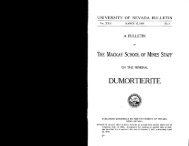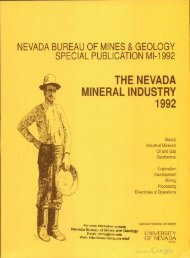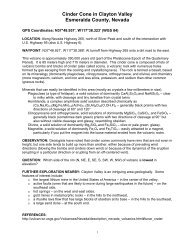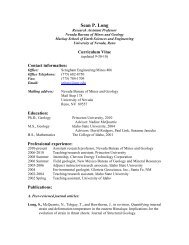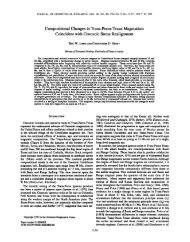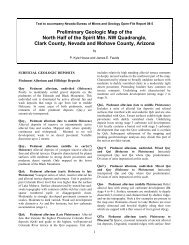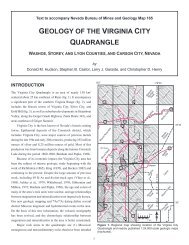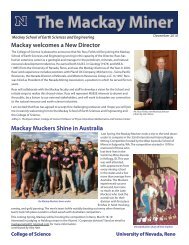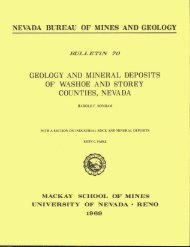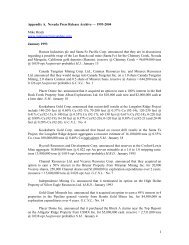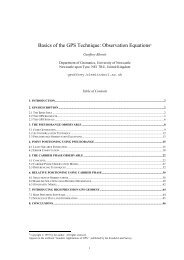Nevada Bureau of Mines and Geology - University of Nevada, Reno
Nevada Bureau of Mines and Geology - University of Nevada, Reno
Nevada Bureau of Mines and Geology - University of Nevada, Reno
You also want an ePaper? Increase the reach of your titles
YUMPU automatically turns print PDFs into web optimized ePapers that Google loves.
comparatively small but <strong>of</strong> high-grade, some <strong>of</strong> the early production in the<br />
district running over LOO pounds <strong>of</strong> mercury per ton.<br />
Three mines out <strong>of</strong> thirteen recognized mines <strong>and</strong> prospects in the<br />
district have produced the majority <strong>of</strong> mercury in the district. They are:<br />
the Blue Can Mine, recorded production <strong>of</strong> 1,733 flasks; the McAdoo Mine<br />
with a recorded production <strong>of</strong> 1,671 flasks; <strong>and</strong> the Red Ore Mine with a<br />
recorded production <strong>of</strong> 1,433 flasks. Coming in a distant fourth is the<br />
White Peaks Mine with a recorded production <strong>of</strong> 773 flasks. The remainder<br />
<strong>of</strong> the mines <strong>and</strong> prospects have either produced nothing or generally less<br />
than LO flasks. Two exceptions to this statement are the Birthday Mine<br />
with a production <strong>of</strong> 270 flasks <strong>and</strong> the Niebuhr Mine with a production <strong>of</strong><br />
40 flasks.<br />
The Blue Can Mine typifies those mines associated with diabase dikes.<br />
This mine initially consisted <strong>of</strong> nine claims <strong>and</strong> connected with the<br />
workings <strong>of</strong> the McAdoo Mine to the north. Early in the history <strong>of</strong> the<br />
property a 50-ton Gould rotary furnace was installed. It was this furnace<br />
which roasted the ore that produced most <strong>of</strong> the mercury from this<br />
property. By 1944 most <strong>of</strong> the ore had been mined <strong>and</strong> processed <strong>and</strong> there<br />
has been no recorded production since this time.<br />
According to Bailey <strong>and</strong> Phoenix the mine was developed by a 135-foot<br />
shaft <strong>and</strong> connecting drifts on the 32, 47, 86, 110, <strong>and</strong> 135 foot levels.<br />
Underground workings total more than 2,000 feet, with about half making up<br />
the 86-foot level. A l l the stopes lay above the two lowest levels.<br />
Bailey <strong>and</strong> Phoenix state that the ore bodies were localized in<br />
fractured parts <strong>of</strong> a north-striking diabase dike which dips westward <strong>and</strong><br />
intrudes argillically altered pre-Tertiary <strong>and</strong> Tertiary sequences <strong>of</strong><br />
sediments, tuffs <strong>and</strong> flows. They divided the ore bodies into two groups-an<br />
eastern group, in which the ore was localized along a 3 to 15-foot wide<br />
diabase dike that extends from the surface to a few feet below the 86-foot<br />
level. The cinnabar is confined to the dike <strong>and</strong> adjacent wallrocks. Then<br />
they had a western group <strong>of</strong> deposits in which ore was localized along an<br />
apex between a vertical dike <strong>and</strong> a heavy layer <strong>of</strong> clay or gouge which dips<br />
at a low angle to the east. In this setting high-grade cinnabar almost<br />
completely replaced a diabase dike.<br />
The Red Ore Mine represents a second type <strong>of</strong> deposit found within the<br />
district. The property consists <strong>of</strong> eight claims located in the<br />
southwestern part <strong>of</strong> the district. Initial discovery was made in 1937 at<br />
which time a few flasks were recovered. But it wasn't until 1956 that the<br />
major ore bodies were developed <strong>and</strong> mined. From 1956 to 1958 over 1,000<br />
flasks <strong>of</strong> mercury were produced from a mill located on the White Peaks<br />
Mine. This mill consisted <strong>of</strong> a 70-ton gravity-flotation concentrator <strong>and</strong> a<br />
retort.<br />
Two ore bodies were developed by open-pit mining. They had a maximum<br />
thickness <strong>of</strong> 15 feet <strong>and</strong> occurred in tuffs <strong>and</strong> an altered basalt flow<br />
which were cut by numerous calcite veins. The cinnabar occurred as<br />
veinlets, <strong>of</strong>ten in association with calcite. Orpiment locally occurred in<br />
"white" veins, <strong>and</strong> opaline silica veins up to two inches wide were<br />
sometimes present. Argillic alteration-is present <strong>and</strong> is most intense<br />
along a steeply dipping, northerly trending fault which defines the west<br />
boundary <strong>of</strong> the pit. The open pit has a depth <strong>of</strong> 70 feet <strong>and</strong> a length <strong>of</strong><br />
about 400 feet.<br />
A third type <strong>of</strong> deposit is expoged at the Niebuh; Mine. This mine was<br />
developed along a fault striking N55 E <strong>and</strong> dipping 65 SE in a brecciated<br />
<strong>and</strong> silicified rhyolite. Cinnabar occurs as coatings <strong>and</strong> disseminations in<br />
Bottle Creek District - 2



